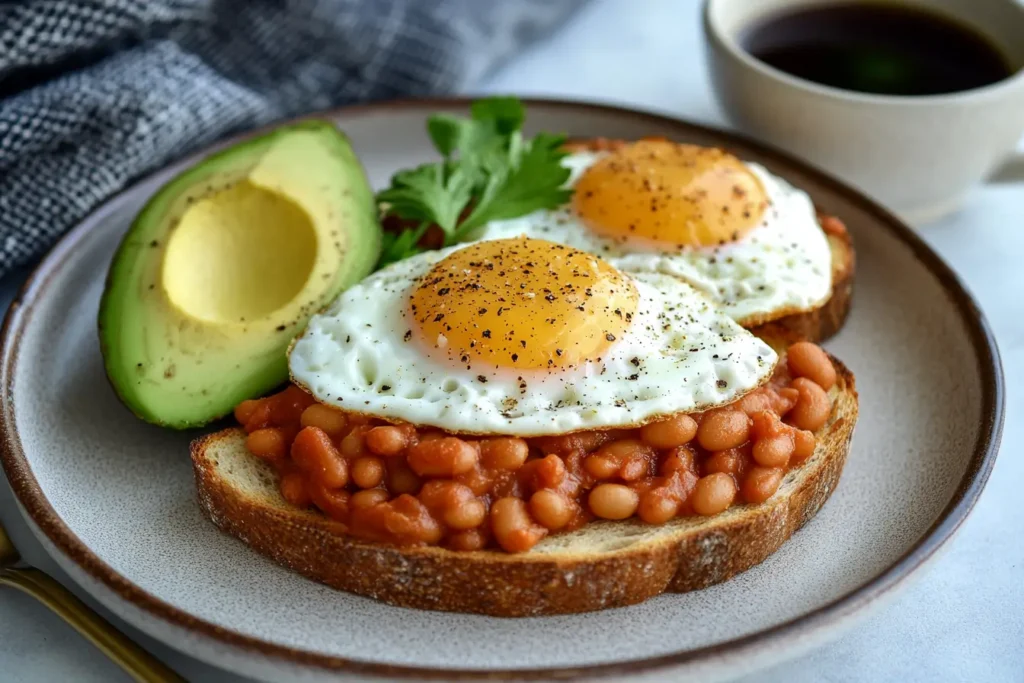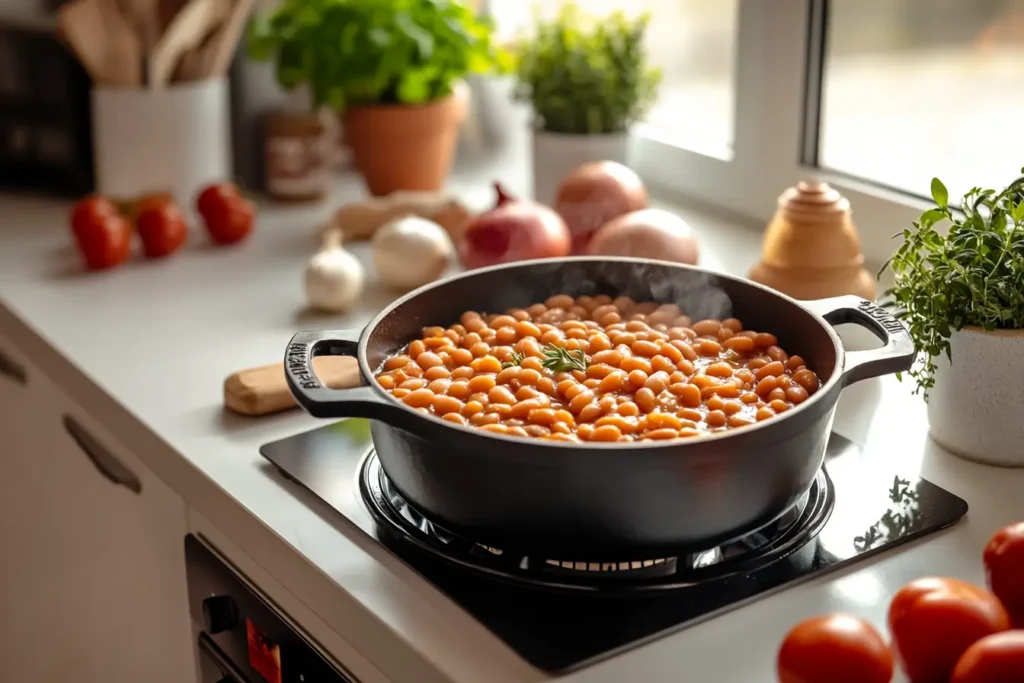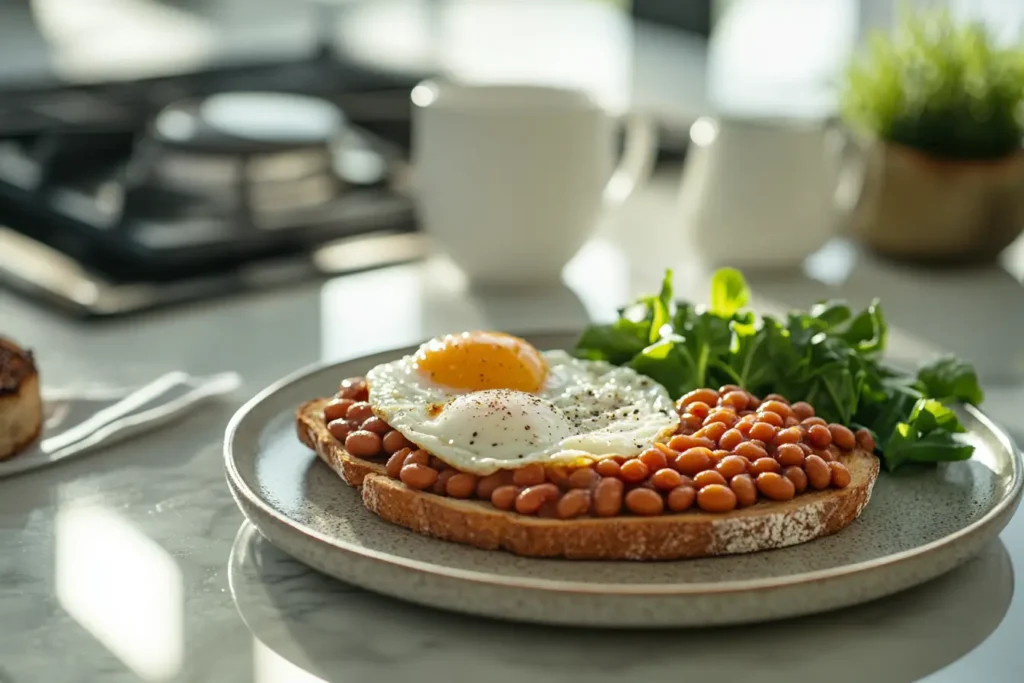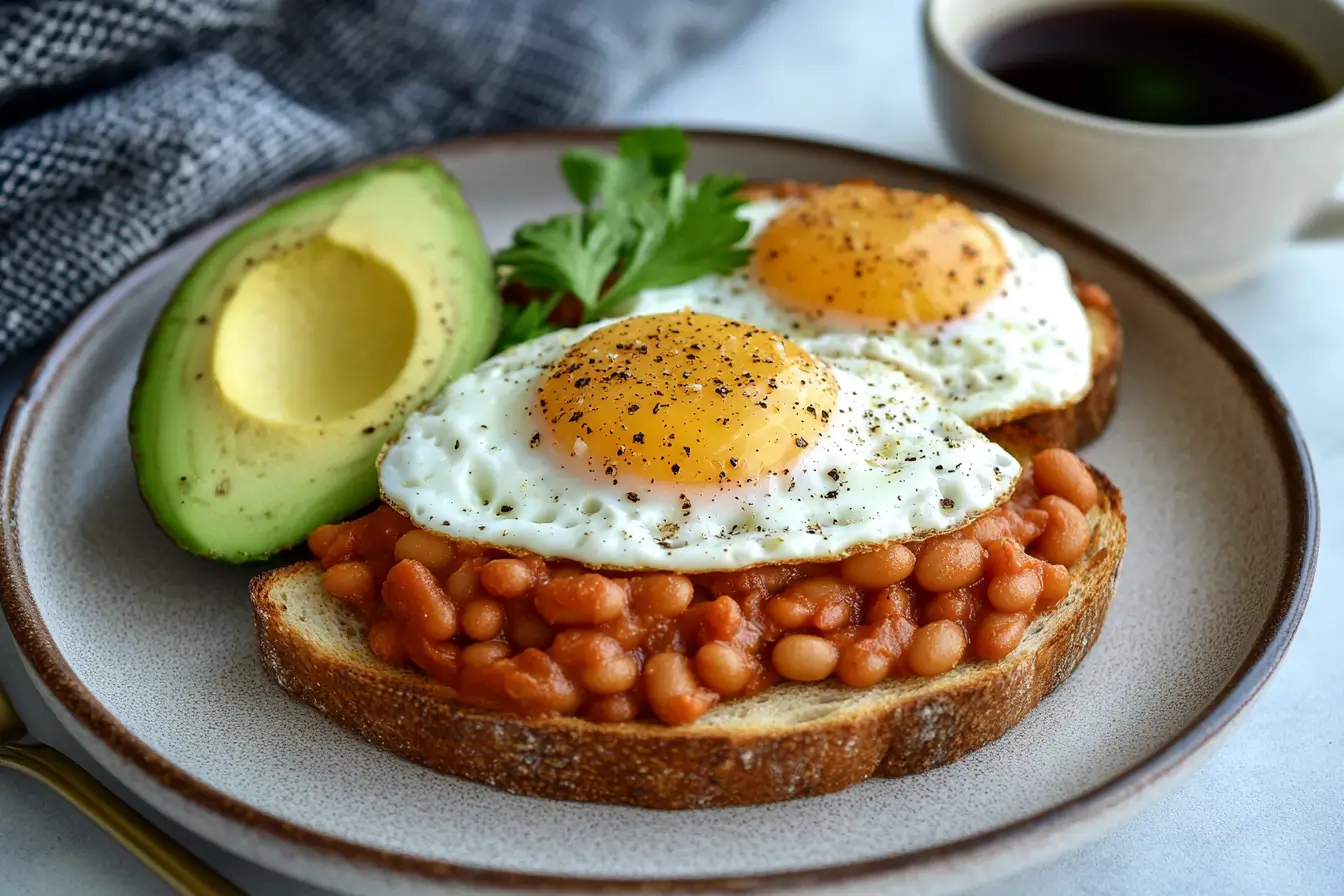
Baked Beans Recipes are a timeless favorite, offering comfort, flavor, and versatility. Whether you’re looking for a quick breakfast option, a side dish for BBQs, or a hearty dinner idea, these recipes showcase how baked beans can elevate any meal.”
What Are Baked Beans?
The Origin and History of Baked Beans
Baked beans recipes aren’t just a random invention—instead, they’ve got a rich history that dates way back. For example, did you know they likely originated with Native American tribes? They used to slow-cook beans with maple syrup and bear fat in clay pots buried in the ground. Talk about rustic cooking! Over time, however, European settlers adapted the recipe, substituting molasses or brown sugar for maple syrup and pork for bear fat.
Fast forward to today, and baked beans have evolved into a beloved dish worldwide. In fact, from traditional New England recipes to British breakfast staples, everyone has their unique twist.
Traditional Ingredients in Baked Beans
At its core, baked beans are a simple dish. The stars of the show are navy beans (also known as haricot beans), which are small, tender, and perfect for soaking up flavors. Then you add a sweet and tangy sauce, typically made from a mix of molasses, brown sugar, tomatoes, and spices. Pork or bacon often sneaks in for that smoky kick.
But here’s the thing: no two recipes are the same. Some people like their beans super sweet, while others prefer a more savory vibe. And that’s the beauty of it—you can tweak the recipe to fit your taste buds.
The Nutritional Value of Baked Beans Recipes
Key Health Benefits of Baked Beans
Let’s bust a myth: baked beans aren’t just tasty; they’re packed with goodness too. They’re an excellent source of plant-based protein, making them a favorite for vegetarians. Plus, they’re loaded with fiber, which is great for your digestion.
Beans are also rich in essential nutrients like iron, magnesium, and potassium. And let’s not forget antioxidants, which help protect your body from damage caused by free radicals. In short, baked beans are a little bowl of health magic. 🌟
Are Baked Beans a Good Protein Source?
Absolutely! If you’re cutting back on meat, baked beans can be a lifesaver. They’re a complete protein when paired with whole grains like bread or rice. So, the next time someone questions your baked bean obsession, just tell them you’re loading up on plant power. 💪
Common Misconceptions About Baked Beans and Health
Sure, baked beans are healthy, but they’ve got a bit of a bad rep thanks to added sugars in canned varieties. The key here is moderation. Look for low-sugar options or make your own to control what goes into them.
How Are Baked Beans Made?

Homemade vs. Store-Bought Baked Beans Recipes
Let’s settle this debate: homemade or store-bought? Store-bought baked beans are convenient (we get it, life is busy), but they can’t compete with the flavor of homemade. When you make them yourself, you control the ingredients, the sweetness level, and the spices. Plus, there’s something so satisfying about simmering beans in a pot for hours, knowing you made them from scratch.
Step-by-Step Recipe for Making Homemade Baked Beans
Want to try your hand at homemade baked beans? Here’s a simple recipe to get you started:
- Soak the Beans: Rinse 2 cups of navy beans and soak them overnight in water.
- Cook the Beans: Drain and rinse the beans, then simmer them in fresh water until tender (about 1-2 hours).
- Make the Sauce: In a pot, mix 1 cup of tomato sauce, ½ cup of molasses, ¼ cup of brown sugar, 2 tablespoons of mustard, and your favorite spices (like paprika or garlic powder).
- Combine: Add the cooked beans to the sauce and let them simmer on low heat for another hour.
- Enjoy: Serve your beans with fresh bread or as a side dish. They’re even better the next day!
“Homemade baked beans are like a hug in a bowl—comforting, warm, and oh-so-delicious.”
Popular Variations: Sweet, Smoky, and Spicy Baked Beans
The beauty of baked beans lies in their versatility. Want something sweet? Add more molasses. Craving smoky flavors? Toss in some smoked paprika or bacon. Feeling adventurous? Spice things up with chili flakes or jalapeños. There’s no wrong way to make baked beans, so let your creativity run wild.
Common Problems When Cooking Baked Beans (And Solutions)
Why Are My Baked Beans Too Watery?
This is a classic issue, and it usually happens when there’s too much liquid or not enough time to cook it down. The fix? Let your beans simmer uncovered for a while to thicken the sauce. You can also mash a few beans to naturally thicken the mixture.
How to Fix Overly Sweet or Bland Baked Beans
Did you overdo it on the sugar? Balance things out with a splash of vinegar or a pinch of salt. If your beans are too bland, add a dash of hot sauce or some smoked paprika to amp up the flavor.
Creative Ways to Serve and Enjoy Baked Beans

Pairing Baked Beans with Other Dishes
Baked beans aren’t just a side dish—they can be the star of the show! Pair them with grilled meats, spoon them over toast, or even serve them alongside scrambled eggs for breakfast. They’re like the Swiss Army knife of the food world.
Turning Baked Beans into a Main Course
Why not let baked beans take center stage? Try making a baked bean casserole, or mix them with ground beef for a hearty chili. You can also stuff them into baked potatoes for an easy weeknight dinner.
“Baked beans are proof that simple ingredients can create extraordinary dishes.”
Innovative Uses of Leftover Baked Beans
Got leftovers? Don’t let them go to waste! Use them as a pizza topping (trust us, it’s amazing), blend them into a bean dip, or add them to a pasta sauce for extra flavor and nutrition.
Baked Beans: Exploring Cuisines, Sustainability, and Perfect Choices
Welcome to Part 2 of our baked beans journey! In this section, we’ll dive deeper into how baked beans appear across the globe, their environmental impact, and how you can pick the best beans for your table. Get ready for another serving of rich, delicious information! 🍲
Baked Beans in Different Cuisines Around the World
American-Style Baked Beans
When you think of American baked beans, you probably imagine that classic barbecue side dish: beans slow-cooked in a sweet and smoky sauce. These beans are a summer cookout essential, often paired with ribs, coleslaw, and cornbread.
The secret to this style lies in molasses, as it gives the dish its signature sweetness. Additionally, adding a touch of smoky bacon or ham transforms it into a pot of pure comfort. In fact, fun fact: in New England, baked beans are traditionally served with brown bread—yes, the kind that’s steamed in a can!
British Baked Beans: A Breakfast Staple
Cross the pond, and baked beans take on a whole new persona. In the UK, they’re synonymous with breakfast. Brits love their beans in a tomato-based sauce, served on toast or as part of a full English breakfast alongside sausages, eggs, and black pudding.
Canned baked beans (like the iconic Heinz variety) are a pantry staple in British homes. They’re quick, easy, and surprisingly versatile. And honestly, is there anything more comforting than beans on toast on a rainy day?
Global Twists on Baked Beans Recipes
Baked beans have traveled the world and, along the way, picked up some amazing variations. For example, in Mexico, you’ll find frijoles charros, a hearty dish of beans cooked with tomatoes, chili peppers, and chorizo. Similarly, in France, cassoulet—a rich, slow-cooked casserole of beans and meat—is a beloved comfort food. Moreover, these variations showcase how beans can adapt to different cultures and cuisines.
Even in Asia, beans make an appearance. Some regions use sweetened beans as a dessert topping! It’s incredible how a simple ingredient can inspire so many different dishes. 🌏
The Environmental Impact of Baked Beans Production
Sustainability of Growing Beans
Let’s talk beans and the planet. For starters, did you know that growing beans is one of the most sustainable forms of agriculture? In fact, legumes like navy beans are nitrogen-fixing plants, which means they not only thrive in various soil conditions but also improve soil fertility by adding nitrogen back into the ground. Moreover, their cultivation requires less water and reduces greenhouse gas emissions, making them an environmentally friendly choice.
Beans also require less water and produce fewer greenhouse gas emissions compared to meat production. So, when you’re enjoying a bowl of baked beans, you’re making a greener choice.
“Beans aren’t just good for you—they’re good for the Earth too.” 🌱
Canned Baked Beans and Waste Management
What about canned baked beans? While the convenience is undeniable, there’s a downside: packaging waste. Thankfully, many brands are now using recyclable or biodegradable materials. You can do your part by recycling cans and opting for bulk purchases to reduce overall packaging.
Pro tip: If you’re worried about preservatives in canned beans, try making your own and storing them in reusable glass jars. It’s a win for you and the planet!
Choosing the Best Baked Beans for Your Needs
How to Read Labels on Canned Baked Beans
Not all canned baked beans are created equal. Some are loaded with added sugars, sodium, and preservatives, so it’s worth checking the label before you buy. Look for options that say “low sugar,” “low sodium,” or “no added preservatives.”
Ingredients to watch out for:
- High-fructose corn syrup: A red flag for unnecessary sugar.
- Artificial flavors: These can dull the natural taste of the beans.
- Excessive sodium: Aim for options with less than 300 mg of sodium per serving.
“Your body deserves the best beans, so take a second to scan the label!”
Comparing Top Baked Beans Brands
Here’s a quick rundown of some popular baked beans brands and what sets them apart:
- Heinz: Classic and iconic, especially in the UK. Known for its slightly sweet and tangy tomato sauce.
- Bush’s Best: A favorite in the US, with a variety of flavors like brown sugar, honey, and vegetarian.
- Eden Foods: A healthier option with organic beans and simple ingredients.
- Amy’s Kitchen: Great for vegetarians and those looking for low-sodium options.
Taste-test a few and see which one hits the spot for you!
The Future of Baked Beans in Modern Diets
Baked Beans in Plant-Based Diets
Here’s a revised version of the paragraph with more transition words for better readability:
As more people shift to plant-based eating, baked beans are becoming a pantry superstar. Not only are they affordable, but they are also nutritious and delicious, making them a great protein source for vegan and vegetarian diets. Furthermore, you can pair them with quinoa or whole-grain bread for a complete and satisfying meal.
Are Baked Beans Suitable for Low-Carb Diets?
If you’re following a low-carb diet, baked beans might not be your go-to. They’re relatively high in carbs due to the natural starches in beans and the added sugars in some recipes. That said, you can enjoy them in moderation or look for low-sugar options to keep your carb count in check.
Conclusion: Why Baked Beans Deserve a Spot on Your Plate
Baked beans are so much more than just a side dish. They’re a culinary chameleon, fitting into countless cuisines and dietary needs. Plus, they’re a sustainable, budget-friendly food that’s good for you and the environment.
So the next time you’re craving something hearty, don’t overlook the humble baked bean. Whether you’re making a classic American barbecue spread, a British breakfast, or trying a global twist, baked beans are here to bring comfort and flavor to your table.
FAQs: Answering Your Burning Questions About Baked Beans Recipes
What’s the Best Way to Include Baked Beans in Breakfast?
Baked beans are an iconic breakfast item, especially in British cuisine. Pair them with eggs, toast, and sausages for a hearty start to your day. If you’re looking for inspiration for breakfast dishes, you might enjoy breakfast casserole ideas that could include baked beans as a tasty addition.
Can I Use Leftover Baked Beans in Other Recipes?
Absolutely! Leftover baked beans are versatile. You can add them to casseroles, soups, or even blend them into a hearty dip. For tips on repurposing leftovers, check out this guide on jazzing up rotisserie chicken, which offers creative ideas you can adapt for beans.
Are There Sweet Versions of Baked Beans?
Yes, sweet baked beans are popular in many regions, particularly in the U.S. They often feature molasses or brown sugar for a rich, caramel-like flavor. For those who enjoy sweet dishes, consider exploring the difference between brookies and blondies—you might find a dessert-inspired pairing for your sweet beans!
Conclusion: Why Baked Beans Deserve a Spot on Your Plate
Baked beans aren’t just food—they’re a cultural icon, a comfort dish, and a nutritional powerhouse. Whether you’re savoring them at breakfast, throwing them into a casserole, or experimenting with global variations, baked beans have a place in every kitchen. Their sustainability, affordability, and versatility make them a hero ingredient for any meal.
So, the next time you crack open a can or whip up a batch from scratch, remember—you’re part of a centuries-old tradition that spans continents and cuisines. Happy cooking! 🍽️

